113 UMMA Objects
113 UMMA Objects
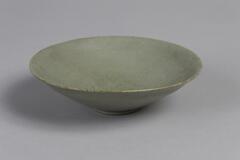
Korean (Korean (culture or style))
Celadon Bowl
Gift of Margaret Condon Taylor in honor of Professor Kim Young Sook
2014/2.106
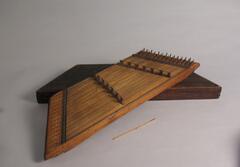
Korean (Korean (culture or style))
Hammer-dulcimer (Yanggeum)
1850 – 1950
Gift and partial purchase from Bruce and Inta Hasenkamp, purchase with funds from Elder and Mrs Sang-Yong Nam
2021/1.158
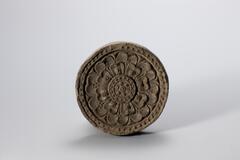
Korean (Korean (culture or style))
Roof-end tile with lotus design
676 – 935
On loan from the YooGeum Museum, Seoul, Korea
LTL2009.7.7
![It has a outward-turned rim. The side of the body is becoming narrow in the base. The bottem is flat.<br />
<br />
This yellowish brown, bowl-shaped, low-fired earthenware vessel is made from fine clay mixed with fine sand particles. It has no neck. The mouth is slightly everted while the rim is generally flat and features some grooves. The body is widest towards the upper-middle section, and the flat base is rounded where it joins the body. Parts of the vessel feature a paddled pattern which suggests that the surface was first paddled and then smoothed with water on a rotary device.<br />
[Korean Collection, University of Michigan Museum of Art (2017) p. 44]<br />
It has a outward-turned rim. The side of the body is becoming narrow in the base. The bottem is flat.<br />
<br />
This yellowish brown, bowl-shaped, low-fired earthenware vessel is made from fine clay mixed with fine sand particles. It has no neck. The mouth is slightly everted while the rim is generally flat and features some grooves. The body is widest towards the upper-middle section, and the flat base is rounded where it joins the body. Parts of the vessel feature a paddled pattern which suggests that the surface was first paddled and then smoothed with water on a rotary device.<br />
[Korean Collection, University of Michigan Museum of Art (2017) p. 44]<br />
](/media/W1siZiIsIjIwMjIvMDkvMjQvNjVoNTM5eGtxal9kZWZhdWx0LmpwZyJdLFsicCIsInRodW1iIiwiMjQweDIwMCJdXQ?sha=d9e7c69efc7a919f)
Korean (Korean (culture or style))
Bowl with flat bottom and flat rolled rim
300 – 499
Gift of Bruce and Inta Hasenkamp and Museum purchase made possible by Elder and Mrs. Sang-Yong Nam
2004/1.160

Korean (Korean (culture or style))
Storage Jar on cut-out pedestal foot
500 – 699
Gift of Bruce and Inta Hasenkamp and Museum purchase made possible by Elder and Mrs. Sang-Yong Nam
2004/1.174
![The gray jar with a little long neck has a foot with rectangular perforations and is potted with fine silt-based clay. The relatively thin mouth is slightly everted. Three deep incisions encircle the midsection of the neck. The globular body is decorated with two incised line encircled the body. The foot whose bottom is rolled outward is a little high and wide.<br />
<br />
The long and splayed neck of this blue-gray, high-fired stoneware jar is encircled by two sets of ridges. The set on the upper section of the neck has two ridges, and the set on the lower section has one ridge. The rim is narrow and round. The inner surface of the neck shows rough, uneven surfaces resulting from wheel throwing. The body is widest at its middle. The vessel surface has been smoothed by paring on a wheel after attaching the low pedestal. The pedestal shows six rectangular perforations.
<p>[Korean Collection, University of Michigan Museum of Art (2017) p. 51]</p>
The gray jar with a little long neck has a foot with rectangular perforations and is potted with fine silt-based clay. The relatively thin mouth is slightly everted. Three deep incisions encircle the midsection of the neck. The globular body is decorated with two incised line encircled the body. The foot whose bottom is rolled outward is a little high and wide.<br />
<br />
The long and splayed neck of this blue-gray, high-fired stoneware jar is encircled by two sets of ridges. The set on the upper section of the neck has two ridges, and the set on the lower section has one ridge. The rim is narrow and round. The inner surface of the neck shows rough, uneven surfaces resulting from wheel throwing. The body is widest at its middle. The vessel surface has been smoothed by paring on a wheel after attaching the low pedestal. The pedestal shows six rectangular perforations.
<p>[Korean Collection, University of Michigan Museum of Art (2017) p. 51]</p>](/media/W1siZiIsIjIwMjIvMDkvMjQvMWNyMzV3bGVrZ19kZWZhdWx0LmpwZyJdLFsicCIsInRodW1iIiwiMjQweDIwMCJdXQ?sha=7b00061238459019)
Korean (Korean (culture or style))
Storage Jar on cut-out pedestal foot
400 – 599
Gift of Bruce and Inta Hasenkamp and Museum purchase made possible by Elder and Mrs. Sang-Yong Nam
2004/1.176
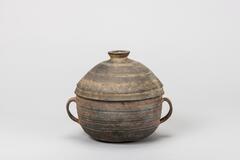
Korean (Korean (culture or style))
Two-handled bowl with cover
400 – 599
Gift of Bruce and Inta Hasenkamp and Museum purchase made possible by Elder and Mrs. Sang-Yong Nam
2004/1.182A&B
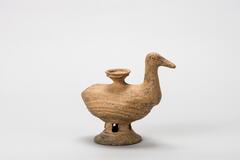
Korean (Korean (culture or style))
Vessel in the shape of a duck
200 – 399
Gift of Bruce and Inta Hasenkamp and Museum purchase made possible by Elder and Mrs. Sang-Yong Nam
2004/1.188
![It has a flat base, globular body and straight neck. There was a bubbling of the clay surface during firing. The attached handle is a little small and thick.<br />
<br />
This is a yellowish gray, low-fired earthenware cup with a handle. The mouth is upright, while the rest of the body has a swollen belly and a round base. The handle attached to the lower middle section of the body is not functional. Traces of rotation and water smoothing are visible on the inner and outer surfaces of the mouth.
<p>[Korean Collection, University of Michigan Museum of Art (2017) p. 68]</p>
<br />
It has a flat base, globular body and straight neck. There was a bubbling of the clay surface during firing. The attached handle is a little small and thick.<br />
<br />
This is a yellowish gray, low-fired earthenware cup with a handle. The mouth is upright, while the rest of the body has a swollen belly and a round base. The handle attached to the lower middle section of the body is not functional. Traces of rotation and water smoothing are visible on the inner and outer surfaces of the mouth.
<p>[Korean Collection, University of Michigan Museum of Art (2017) p. 68]</p>
<br />
](/media/W1siZiIsIjIwMjIvMDkvMjQvMWQybmE1M3FtYl9kZWZhdWx0LmpwZyJdLFsicCIsInRodW1iIiwiMjQweDIwMCJdXQ?sha=618fba87ddd6f364)
Korean (Korean (culture or style))
Small Single-Handed Cup
5th century
Gift of Bruce and Inta Hasenkamp and Museum purchase made possible by Elder and Mrs. Sang-Yong Nam
2004/1.190
![<p>Carved on both sides, this wooden printing block records Origin of Household Rites (家禮源流, Garyewollyu), a collection of writings on household rites categorized and summarized during the reign of King Hyeonjong (顯宗, r. 1659-1674) of Joseon by a scholar named Yu Gye (兪棨, 1607-1664). This block contains part of Fascicle 4 of the text Origins of Household Rites entitled “Going to Welcome the Bride (親迎, chinyeong, Ch. qinying),” the procedure in which the groom welcomes the bride at a wedding ceremony. Korea was the first country in the world to use the technique of carving letters on woodblocks and using them for printing. After the invention of metal type in the early Joseon period, woodblock printing was used to publish scriptures, anthologies and family records in Buddhist temples, Confucian academies and households.</p>
<p>[Korean Collection, University of Michigan Museum of Art (2017) p. 290]</p>
<p>Carved on both sides, this wooden printing block records Origin of Household Rites (家禮源流, Garyewollyu), a collection of writings on household rites categorized and summarized during the reign of King Hyeonjong (顯宗, r. 1659-1674) of Joseon by a scholar named Yu Gye (兪棨, 1607-1664). This block contains part of Fascicle 4 of the text Origins of Household Rites entitled “Going to Welcome the Bride (親迎, chinyeong, Ch. qinying),” the procedure in which the groom welcomes the bride at a wedding ceremony. Korea was the first country in the world to use the technique of carving letters on woodblocks and using them for printing. After the invention of metal type in the early Joseon period, woodblock printing was used to publish scriptures, anthologies and family records in Buddhist temples, Confucian academies and households.</p>
<p>[Korean Collection, University of Michigan Museum of Art (2017) p. 290]</p>](/media/W1siZiIsIjIwMjIvMDkvMjQvOG85Nngzcm0ydl9kZWZhdWx0LmpwZyJdLFsicCIsInRodW1iIiwiMjQweDIwMCJdXQ?sha=c43173df44c72bda)
Korean (Korean (culture or style))
Wood Block for Printing
19th century
Gift of Bruce and Inta Hasenkamp and Museum purchase made possible by Elder and Mrs. Sang-Yong Nam
2004/1.316
![Large oblong, rectangular wooden bowl with rounded ends.<br />
<br />
These large bowls (<em>hamji</em>) were made by carving out large, single pieces of wood. Notches or handles have been carved out on two opposite sides of the outer walls, making them easy to carry. Round hamji bowls were sometimes carved on a turning lathe, but those with notches could be made by carving out single lengths of wood with an adz. These bowls were used in towns and the countryside alike. Affluent households would possess sets of large, medium-sized, and small bowls with notches piled up together. When grinding mung beans, beans, or red beans, such bowls are placed below a grindstone supported by a tripod.
<p>[Korean Collection, University of Michigan Museum of Art (2017) p. 274]</p>
Large oblong, rectangular wooden bowl with rounded ends.<br />
<br />
These large bowls (<em>hamji</em>) were made by carving out large, single pieces of wood. Notches or handles have been carved out on two opposite sides of the outer walls, making them easy to carry. Round hamji bowls were sometimes carved on a turning lathe, but those with notches could be made by carving out single lengths of wood with an adz. These bowls were used in towns and the countryside alike. Affluent households would possess sets of large, medium-sized, and small bowls with notches piled up together. When grinding mung beans, beans, or red beans, such bowls are placed below a grindstone supported by a tripod.
<p>[Korean Collection, University of Michigan Museum of Art (2017) p. 274]</p>](/media/W1siZiIsIjIwMjIvMDkvMjQvMmFtMWgzNXk0c19kZWZhdWx0LmpwZyJdLFsicCIsInRodW1iIiwiMjQweDIwMCJdXQ?sha=abbd1ecb4867c0dc)
Korean (Korean (culture or style))
Wooden Bowl
1850 – 1950
Gift of Ok Ja Chang and the Chang Family
2009/2.29
![Wooden table with a dodecagon table top and rounded out legs.<br />
<br />
This dog-legged tray-table has its name derived from the shape of its curved legs which resemble those of dogs. The table top and its raised brim are made from the same single piece of thick board. Aprons between the legs, immediately under the table top, are not shaped in identical proportion, as they were initially made long and were shortened where it was needed. Bamboo pegs are driven into the table top to join it with the aprons, and the stretchers are nailed to the legs by nails driven in from the bottom.
<p>[Korean Collection, University of Michigan Museum of Art (2017) p. 258]</p>
Wooden table with a dodecagon table top and rounded out legs.<br />
<br />
This dog-legged tray-table has its name derived from the shape of its curved legs which resemble those of dogs. The table top and its raised brim are made from the same single piece of thick board. Aprons between the legs, immediately under the table top, are not shaped in identical proportion, as they were initially made long and were shortened where it was needed. Bamboo pegs are driven into the table top to join it with the aprons, and the stretchers are nailed to the legs by nails driven in from the bottom.
<p>[Korean Collection, University of Michigan Museum of Art (2017) p. 258]</p>](/media/W1siZiIsIjIwMjIvMDkvMjQvNzRsNmlobWYwc19kZWZhdWx0LmpwZyJdLFsicCIsInRodW1iIiwiMjQweDIwMCJdXQ?sha=2edc8f3a2585cc9d)
Korean (Korean (culture or style))
Wooden Table
1850 – 1950
Gift of Ok Ja Chang and the Chang Family
2009/2.34
Loading…
